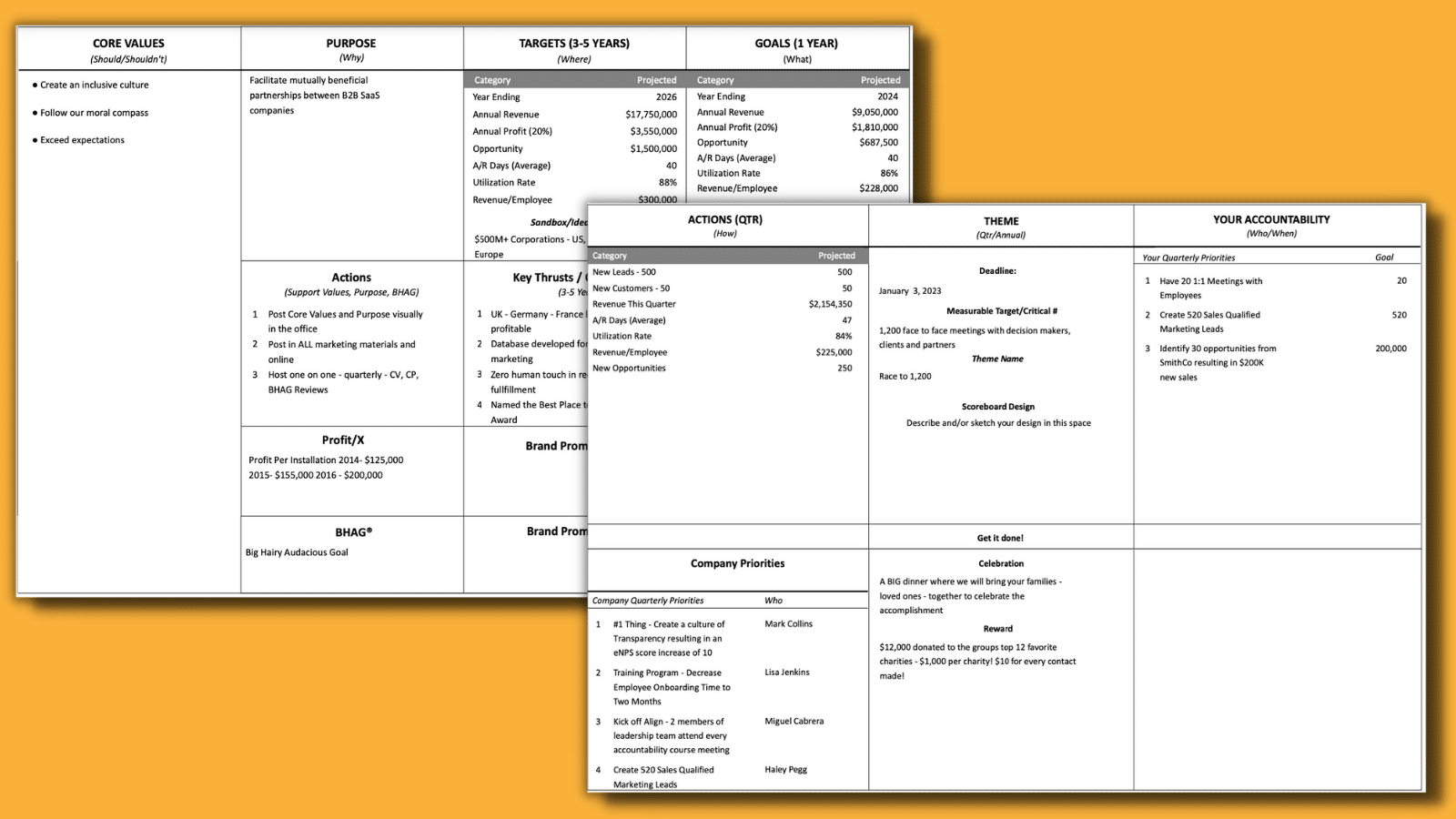Key Components of a One Page Strategic Plan
In the words of legendary Chinese military strategist Sun Tzu, “Strategy without tactics is the slowest route to victory. Tactics without strategy is the noise before defeat.” Deciding where you want to be is just the first step of creating a plan, but the real work comes into play when you are able to define milestones and implement tactics that will pave the way toward getting there. Laying out company goals and a means to achieve them is the best way to rally and motivate a team, and a well-crafted One Page Strategic Plan is the first thing you need to start making progress and seeing results!
The successful Scaling Up and Rockefeller Habits business methodologies emphasizes a powerful framework for a One Page Strategic Plan (OPSP) that outlines the key elements necessary to scale a business. The OPSP is purposely mapped out both vertically and horizontally so that it is easy to follow and every section is relevant to the big picture. There are a few variations of the OPSP, but all include six key components:
1) Core Values
Core values are an essential part of a company’s identity and culture. They provide the foundation for how employees interact with each other, their customers, and the business environment in general. Core values define what is important to a company and guide decisions about how it should operate. When values are well-defined and consistently applied, they can be powerful drivers of success as well as a source of motivation for employees. By clearly articulating core values, you can set expectations that will help create an atmosphere where everyone is aligned around common goals and works toward achieving them together.
Staying aligned with core values is a challenge many business leaders face, as staying true to them can be difficult when faced with the demands of rapid growth and change. Businesses must have a clearly articulated set of core values that are communicated regularly so that employees are able to stay true to them in their day-to-day decisions.
2) Purpose
Your purpose is your “why”. The reason behind your work. Your motivation for success. The purpose statement should clearly define the reason for an organization’s existence. It serves as a guiding principle for the company and its employees, articulating the company’s mission and values, and providing direction for executive decision-making.
Several businesses expand on their purpose by identifying a measurable grand and ambitious goal. A “Big Hairy Audacious Goal,” as it’s sometimes called, is a bold, challenging goal that defines where your company wants to be in 10 to 25 years. It provides direction and focus by linking motivations to a long-term strategy and helps keep everyone aligned as the company grows.
The Big Hairy Audacious Goal (BHAG) should be reflective of your core values and mission statement, tying the roots of your organization to the overall impact you want to make. The BHAG is your best case scenario. Your dreams come true. It’s perfectly okay to set a BHAG without having a clear vision for how to achieve it, as long as the goal itself is motivating to you and your team.
3) Targets
Targets are your measurable goals, complete with data points that gauge progress. Experienced business leaders know that a data-driven approach is the best way to ensure accuracy of progress reports, and setting clear targets opens the door to do this effectively. Targets can be broken down on the OPSP into specified timeframes, including Quarterly, Annual and Three-to-Five-Year Targets. Setting both short-term and long-term targets provides a strategic balance between immediate goals and long-term vision.
4) Themes
The purpose of a quarterly theme is to incentivize team members with gamification and rewards, leading to increased productivity and dedication. When employees are rewarded for their achievements, they feel valued and appreciated for their contributions. Techniques that turn work into a game with rules, rewards, and consequences can make work feel less like a chore and more like a challenge. This will increase employee engagement and motivation, as employees are motivated by the thrill of competition and the excitement of earning rewards.
By linking rewards to the achievement of specific goals related to the theme, employees are motivated not just by the rewards themselves, but by the knowledge that their efforts are contributing to something larger and meaningful. Using themes to align goals with daily work also helps ensure all team members stay focused on the goals at hand and are aware of the “why” behind their daily actions.
5) Your Accountability
The Accountability section of the OPSP identifies who is responsible for each target. Delegating tasks by assigning roles and responsibilities is a crucial part of turning strategy into execution by ensuring each priority is covered and none fall through the cracks. Promoting accountability within a team comes with numerous benefits — from a more collaborative culture, to better trust and transparency among team members, to stronger performance and motivation to exceed expectations.
6) SWOT / SWT
A traditional SWOT Analysis covers a company’s Strengths, Weaknesses, Opportunities and Threats. The SWOT Analysis facilitates the assessment of current resources and capabilities to identify areas for growth. Knowing where your competitive advantages lie, as well as what external factors may affect the future of your business, can help you identify potential threats and take advantage of opportunities.
Some versions of the OPSP put a spin on the traditional SWOT Analysis with a variation that incorporates Trends into the evaluation of Threats. This revised Analysis called the SWT tool can be used in addition to SWOT to help build upon Opportunities by identifying key positive and negative trends that may affect a business’s trajectory. These two types of analyses used in conjunction with one another help ensure that a business strategy is up to date and whether or not a company is on track to reach its goals.
Final Touches
The perfect plan does not exist, but to have the best framework possible that is effective and adaptable to various circumstances, your business must start with a well-defined and oriented One Page Strategic Plan. Keep your plan concise and to the point to eliminate the tendency to be distracted and ensure you remain focused on the end-goal. It will also help fill in gaps that you didn’t know existed by implementing a structured approach to planning and execution. The end result? A clear, concise, and achievable plan that sets your business up for long-term success.
Moreover, your One Page Strategic Plan is most effective when it is readily available to the whole team. Providing visibility of the company plan is helpful for ensuring all employees are aware of the plan, the destination, and their role in contributing to it. The OPSP is not always something that comes together quickly – it can take numerous reviews quarter after quarter to build a solid plan, but the more you involve your team and welcome their feedback, the better.
If you’re ready to start building out your OPSP, the Align software can help! Align comes with a built-in OPSP template, along with various other tools, that can be used alongside the strategies outlined in this article to help you create a plan that drives results and keeps your team aligned.
Ready to get started? Book your demo today.





